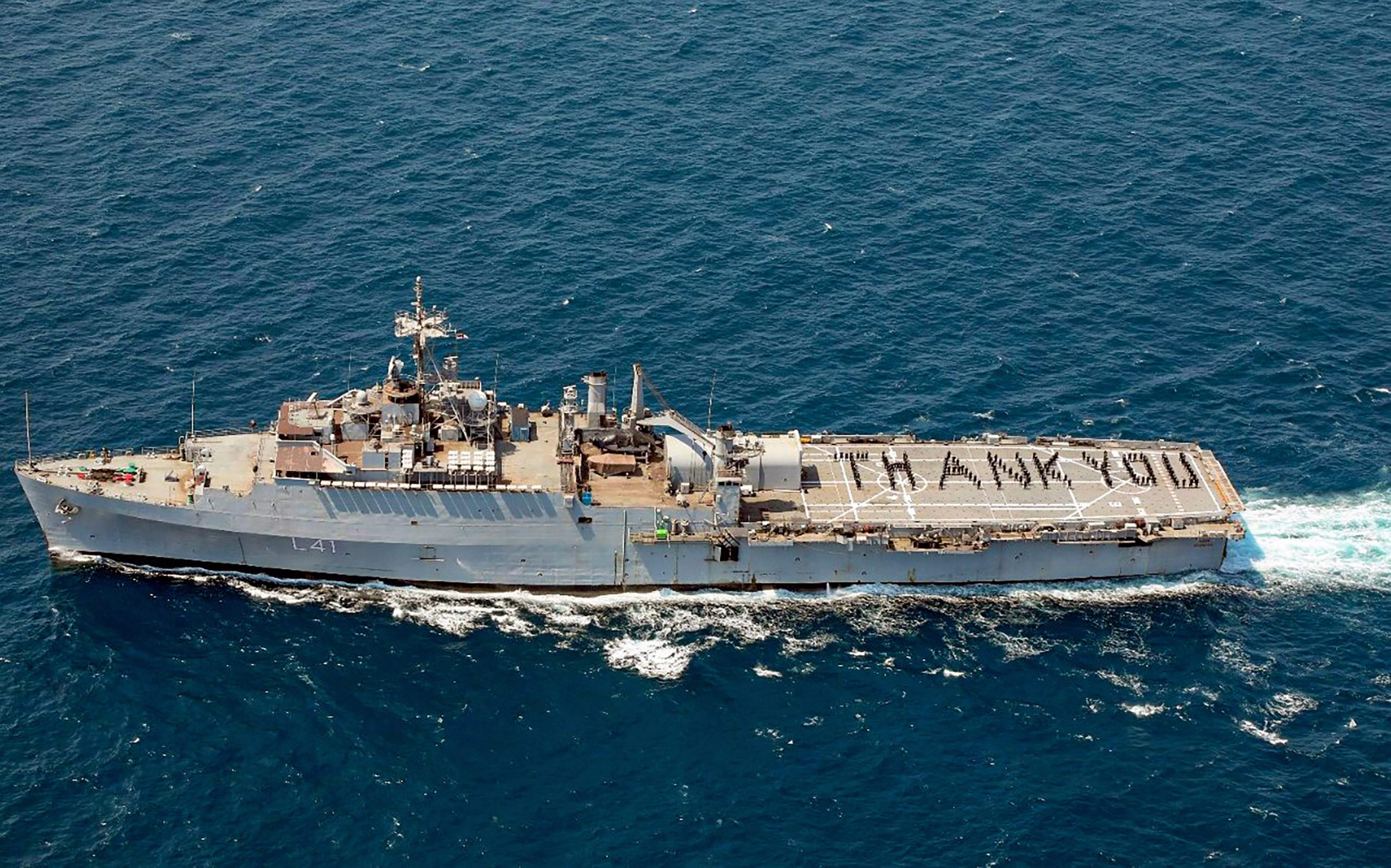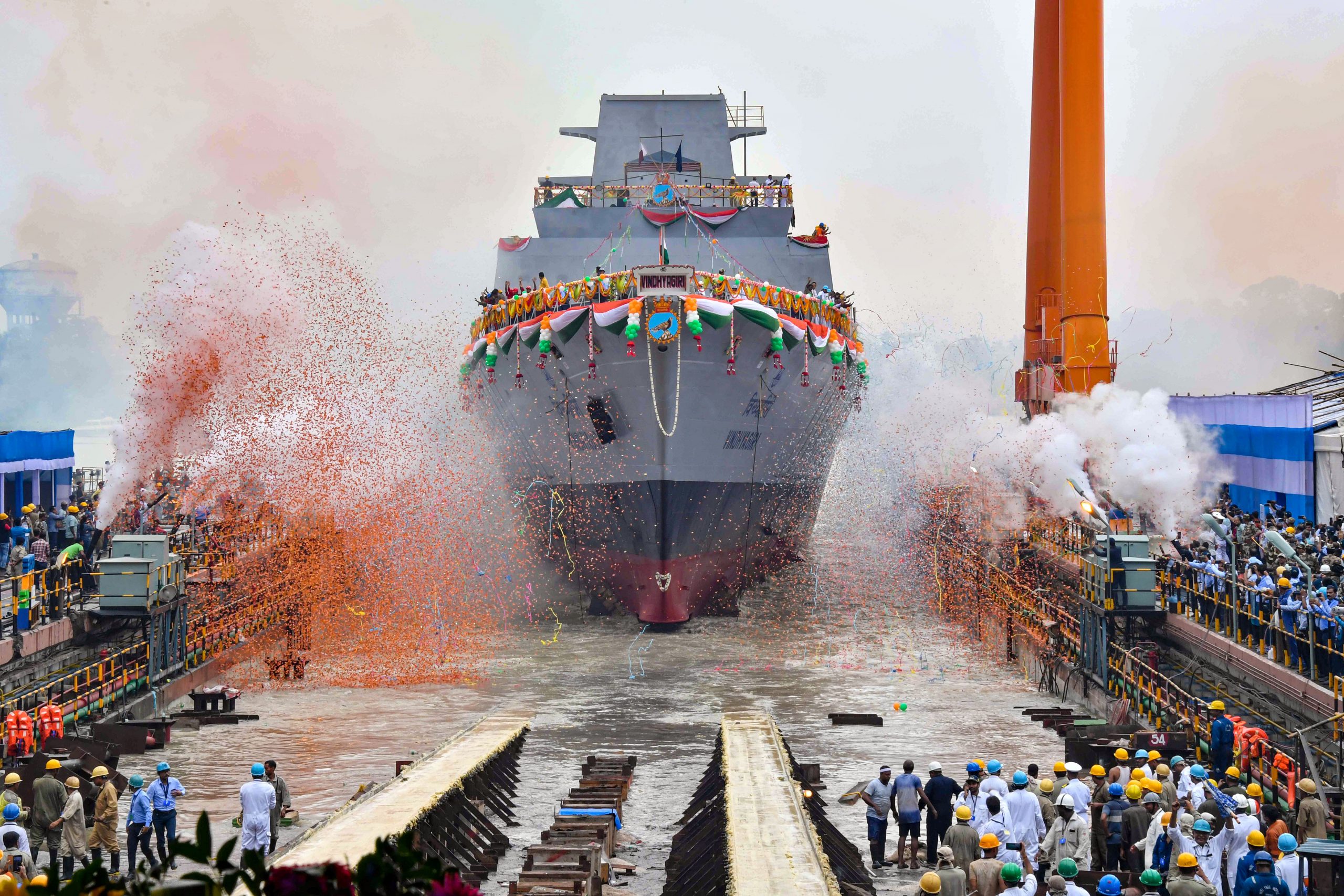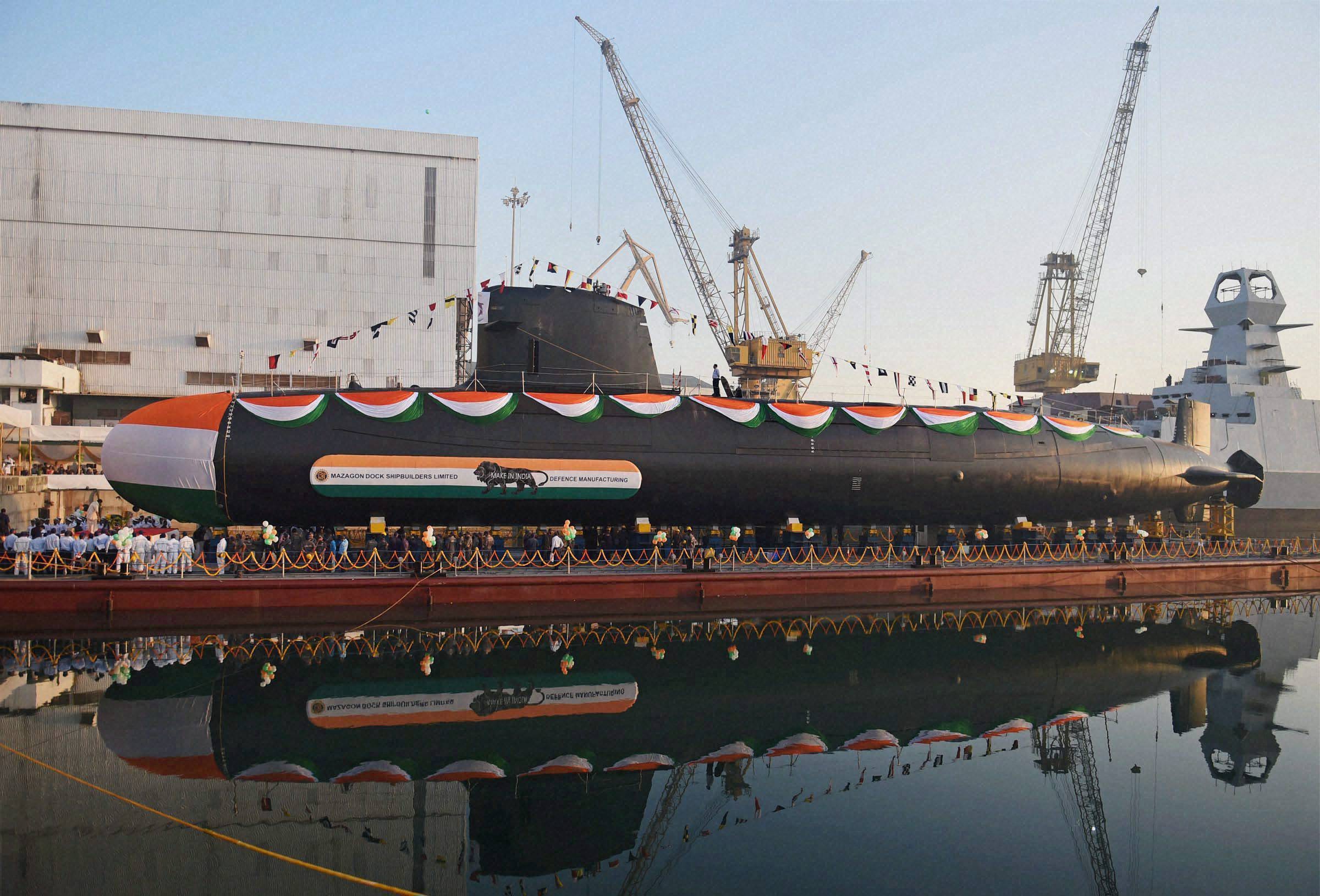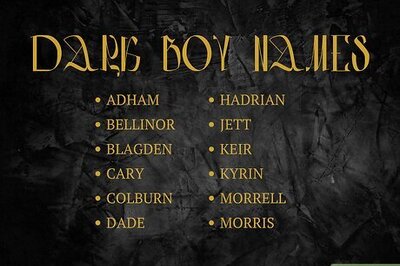
views
corvette, submarine and amphibious assault ships
The Indian Navy will commission INS Imphal, the indigenously-built stealth guided missile destroyer equipped with BrahMos surface-to-surface missiles, on Tuesday in a boost to its maritime capability amid China’s increasing forays into the Indian Ocean region.
INS Imphal is the first warship to have been named after a city from the Northeastern region, the approval for which was accorded by the President in April 2019.
The commissioning ceremony will mark the formal induction into the Navy of the third of the four ‘Visakhapatnam’ class destroyers, indigenously designed by the Indian Navy’s in-house organisation, Warship Design Bureau.
As per recent reports, the Indian Navy has 3 aircraft carriers, one Amphibious transport dock, 8 landing ship tanks, 10 destroyers, 13 frigates, 23 corvettes and 3 nuclear submarines. The Indian Navy combat ships are divided into seven main categories: aircraft carriers, destroyers, frigates, corvettes, submarines and amphibious assault ships.
Here’s a look at the list of all active Indian Navy ships currently in service:
Aircraft Carriers
INS Vikrant
India celebrated a historic milestone as it commissioned its first ever Indigenous Aircraft Carrier (IAC) Vikrant in September 2022, designed by Indian Navy’s in-house Warship Design Bureau (WDB) and built by Cochin Shipyard Limited. INS Vikrant has been built with state-of-the-art automation features and is the largest ship ever built in the maritime history of India.

The ship would be capable of operating air wing consisting of 30 aircraft comprising of MIG-29K fighter jets, Kamov-31, MH-60R multi-role helicopters, in addition to indigenously manufactured Advanced Light Helicopters (ALH) and Light Combat Aircraft (LCA) (Navy). The Indigenous Aircraft Carrier is named in honour of her historic predecessor INS Vikrant, India’s first aircraft carrier, which played an important part in the war of 1971.
INS Viraat
INS Viraat, now decommissioned, is the oldest aircraft carrier in the world and was decommissioned in Cochin Shipyard in September 2016. INS Viraat was commissioned into Indian Navy on 12th May 1987 at Plymouth, UK.
The iconic warship played a major role in Operation Jupiter in July 1989, Operation Parakram in 2013 following and Operation Vijay during 1999 Kargil War after commissioned into navy. The ship operated Sea Harrier (White Tigers- fighter aircrafts), Seaking 42B (Harpoons- Anti Submarine helicopters) and Seaking 42C (Commando Carrier helicopters) and Chetak (Angles- SAR helicopter) as her main air elements.
INS Vikramaditya
Russia’s refurbished Admiral Gorshkov was commissioned into the Indian Navy as INS Vikramaditya at Severodvinsk. It was Indian Navy’s biggest ship and capable of operating a versatile range of high-performance aircrafts, such as the MiG 29K fighters, KM 31 AEW helicopters, multi-role Seakings and utility Chetaks. The ship is over 285 meters long and 60 meters wide.
The ship has the ability to carry over 30 aircrafts, comprising an assortment of MiG 29K/Sea Harrier, Kamov 31, Kamov 28, Sea King, ALH-Dhruv and Chetak helicopters.
Amphibious Transport Dock
INS Jalashwa
INS Jalashwa is an amphibious transport dock currently in service with the Indian Navy. Formerly USS Trenton, INS Jalashwa along with six Sikorsky SH-3 Sea King helicopters were procured from the United States by India in 2005.

Commissioned in June 2007, INS Jalashwa is the only Indian naval ship to be acquired from the US. It is based in Visakhapatnam under the Eastern Naval Command. With a displacement of 16,400 tonnes and 179 meters length, she is the Indian Navy’s second largest warship. INS Jalashwa was deployed by Indian navy for evacuation of Indians from Maldives and Sri Lanka on a number of occasions as part of Operation Samudra Setu.
Tank Landing Ships
- INS Magar: Indian Naval Ship Magar, the oldest Landing Ship Tank (Large) of the Indian Navy, decommissioned after 36 years of exceptional service to the nation. The ship was indigenously built by Garden Reach Shipbuilders and Engineers Ltd, Kolkata and was launched in November 1984 and commissioned into the Indian Navy in July 1987. The ship has a displacement of 5,600 tonnes, a length of 125 metres, a beam of 17 metres and has been a vital asset of the Indian Navy for over 30 years and participated in various naval operations ranging from amphibious operations, Fleet deployments and HADR missions.
- INS Gharial: INS Gharial is a Magar-class amphibious warfare vessel of the Indian Navy that transports and deploys troops, vehicles, and equipment. It has played a vital role in various military exercises and operations, showcasing its ability to support ground forces in different scenarios.
- INS Kesari: INS Kesari, the fourth indigenously built landing ship tank of Indian Navy was commissioned in April 2008 at Naval Base in Visakhapatnam. INS Kesari undertook similar missions between May and June 2020 to provide humanitarian and medical assistance to Maldives, Mauritius, Seychelles, Madagascar and Comoros.
- INS Tir: INS Tir, the indigenously built cadet training ship of the Indian Navy, was built by Mazagon Dock Shipbuilders Limited and was commissioned into the Navy in February 1986. Based in Kochi under Southern Naval Command (SNC), INS Tir is also the senior ship of the First Training Squadron.
- INS Shardul: INS Shardul is the lead ship of her class of amphibious warfare vessels, currently in active service. It is a Landing Ship Tank of the Indian Navy whose primary role is to transport troops, vehicles, armaments and accomplish all objectives of an amphibious operation which primarily includes landing of combat equipment and personnel to an Amphibious Objective Area.
- INS Vijit: ICGS Vijit is the second in the series of 90-meter Offshore Patrol Vessels and was commissioned at Goa in Dec 2010. The ship is designed to carry one twin-engine HAL built Advance Light Helicopter and five high-speed boats for Search and Rescue, Maritime Law Enforcement and Marine Pollution Response.
Navy Destroyers
Destroyer warships come in a range of sizes and is a fast, manoueverable, long-distance warship intended to escort larger vessels in a fleet, convoy or battle group and defend them against smaller, short-range attackers.
Delhi Class Destroyer
The Delhi class destroyers are classified as guided-missile destroyers. The Delhi class vessels are the largest warships to be fully designed and built in India. INS Delhi, INS Mysore, and INS Mumbai are part of the Delhi-class destroyers.
Kolkata Class Destroyer
Kolkata class destroyers are follow-on of the Delhi class destroyers which entered service in the late 1990s. The Kolkata-class destroyer consists of INS Kolkata (2014), INS Kochi (2015), and INS Chennai (2016).
Rajput Class Destroyers
The Rajput class ships were commissioned by the Indian Navy between 1980-88. It consists of INS Rajput (1980), INS Rana (1982), INS Ranjir (1983), INS Ranveer (1986), and INS Ranvijay (1987). The Indian Navy ordered 5 modified Kashin II class guided missile destroyers from the Soviet Union in the 1970s.
Visakhapatnam Class Destroyer
The Visakhapatnam class, or Project 15B, is a new Indian destroyer and a follow on to the Kolkata class destroyer. Based on the same design as the Kolkata class, the destroyed has improved stealthiness and increased automation. It includes INS Visakhapatnam (2021), INS Mormugao (2022), INS Imphal (2023), and INS Porbandar (under construction).
Navy Frigates
Frigates are designed for quick manoeuvrability and can be used to escort and protect larger vessels from air, surface and underwater threats. They protect other ships of the fleet, merchant marine ships and amphibious expeditionary forces from threats emanating from the sea, especially submarines.
- INS Shivalik: INS Shivalik is the lead ship of her class of stealth multi-role frigates built for the Indian Navy. It is the first stealth warship built by India and built with enhances stealth features. The construction of the vessel began in 2001 and was completed by 2009. It was commissioned on 29 April 2010.
- INS Satpura: INS Satpura is an indigenously designed and built, 6000 tonne guided missile stealth frigate equipped to seek and destroy adversaries in air, surface and underwater. The ship is a frontline unit of the Eastern Fleet based at Visakhapatnam.
- INS Sahyadri: The INS Sahyadri is a Shivalik class multi-role stealth frigate and is part of Indian Navy’s Eastern Fleet based at Visakhapatnam. INS Sahyadri is fitted with state-of-the-art weapons and sensors, which makes her capable of detecting and neutralising air, surface and sub-surface threats.
- INS Talwar: INS Talwar gets its name from the traditional sword, and is the first of the Talwar class stealth frigates commissioned into the Indian Navy in 2003. INS Talwar has a length of 125 meters and is capable of speeds upto 30 knots. She is equipped with an array of weapons and sensors which include surface to surface and surface to air missiles, medium and shortrange guns, anti-submarine torpedoes, rockets and an advanced electronic warfare and communication suite.
- INS Trishul: INS Trishul is the second frigate of the Talwar class of the Indian Navy and was commissioned in 2003.
- INS Tabar: Indian Naval Ship INS Tabar was mission-deployed in international waters for over three months from June 2021. During the deployment, she made 11 port calls in nine countries of Europe and Africa, traversing nearly 20,000 nautical miles. The ship is equipped with a versatile range of weapons and sensors and is a part of the Indian Navy’s Western Fleet which is based in Mumbai under Western Naval Command.
Navy Corvettes
A Corvette is the smallest class of naval ships and falls below the warship class of a frigate. The Corvettes are highly agile ships and categorised as missile boats, anti-submarine ships, coastal patrol crafts and fast attack naval vessels.
INS Kamorta
INS Kamorta is first Anti-Submarine Warfare (ASW) of the four Stealth Corvettes designed by the Indian Navy under Project 28. Measuring 110 meters in length, 14 meters in breadth and displacing 3500 tons, the ship can achieve speed of 25 Knots. It is fitted with Anti-submarine Rockets and Torpedoes, Medium and Close-in Weapon Systems and indigenous surveillance radar Revathi. The ship is also capable of carrying an integral ASW helicopter.

INS Kadmatt
INS Kadmatt is second of the four indigenous ASW corvettes of the Indian Navy. Commissioned in 2016, the ship has participated in numerous joint naval exercises with friendly nations, contributing to regional security and fostering maritime ties. The ship is equipped with state-of-the-art weapon and sensor package, enabling her to carry out wide range of missions.
INS Kiltan
INS Kiltan, third ASW stealth corvettes, was commissioned into the Indian Navy by Defence Minister Nirmala Sitharaman in 2017. Regarded as a very prestigious acquisition, INS Kiltan is one of the most potent warships to have been constructed in India. The sleek and magnificent ship is propelled by ‘Combination of Diesel and Diesel (CODAD)’ propulsion system of four diesel engines to achieve speeds in excess of 25 knots and has an endurance of around 3,500 nautical miles.
INS Kavaratti
INS Kavaratti, the last of four indigenously built ASW stealth corvettes, was commissioned into the Navy in October 2020. Kavaratti has a state-of-the-art weapons and sensor suite capable of detecting and prosecuting submarines. In addition to its anti-submarine warfare capability, the ship also has a credible self defence capability and good endurance for long-range deployments.
Submarines
India has 16 conventional and 3 nuclear submarines in service as of now. The submarine fleet includes seven Russian Kilo class submarines, four German HDW submarines, five Scorpene class submarines, and the indigenous nuclear ballistic missile submarine INS Arihant.
Kalvari Class
INS Kalvari is the first of the six Scorpene class submarines built under Project 75. The Submarine was commissioned on 14 December 2017. It includes Vagir, Kalvari, Khanderi, Karanj and Vela.

Sindhughosh Class
Sindhughosh class submarines are the Kilo class diesel-electric submarines and the country possesses eight working Sindhughosh-class diesel-electric attack submarines. The submarines have a displacement of 3,000 tonnes, a maximum diving depth of 300 meters, top speed of 18 knots, and are able to operate solo for 45 days with a crew of 53. It consists of Sindhugosh, Sindhuraj, Sindhuratna, Sindhukesari, Sindhukirti, Sindhuvijay and Sindhushashtra.
Shishumar Class
The Shishumar class vessels (Type 1500) are diesel-electric submarines. These submarines are developed by the German yard Howaldtswerke-Deutsche Werft (HDW). Shishumar, Shankush, Shalki and Shankul.
INS Arihant
India’s first ballistic missile nuclear submarine (SSMN) INS Arihant carried out a successful launch of a Submarine Launched Ballistic Missile (SLBM) in October 2022. Launched in July 2009, INS Arihant is India’s first home-made nuclear submarine which was commissioned in 2016. “INS Arihant is armed with the short-range K-15 missiles. Developmental trials of the K-4 SLBM (with a 3,500-km range) have been completed but it is yet to be fully inducted,” according to a report in The Times of India.


















Comments
0 comment